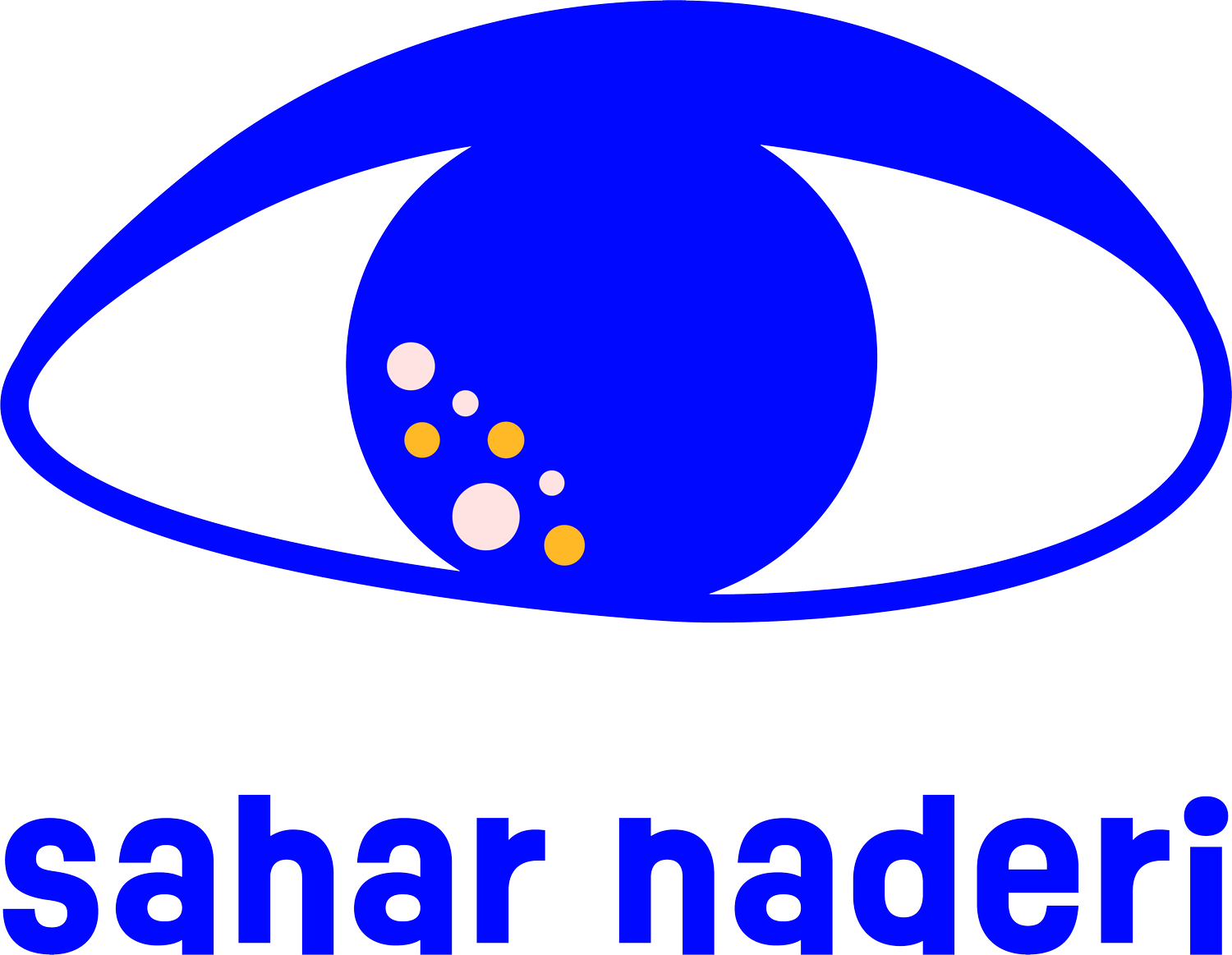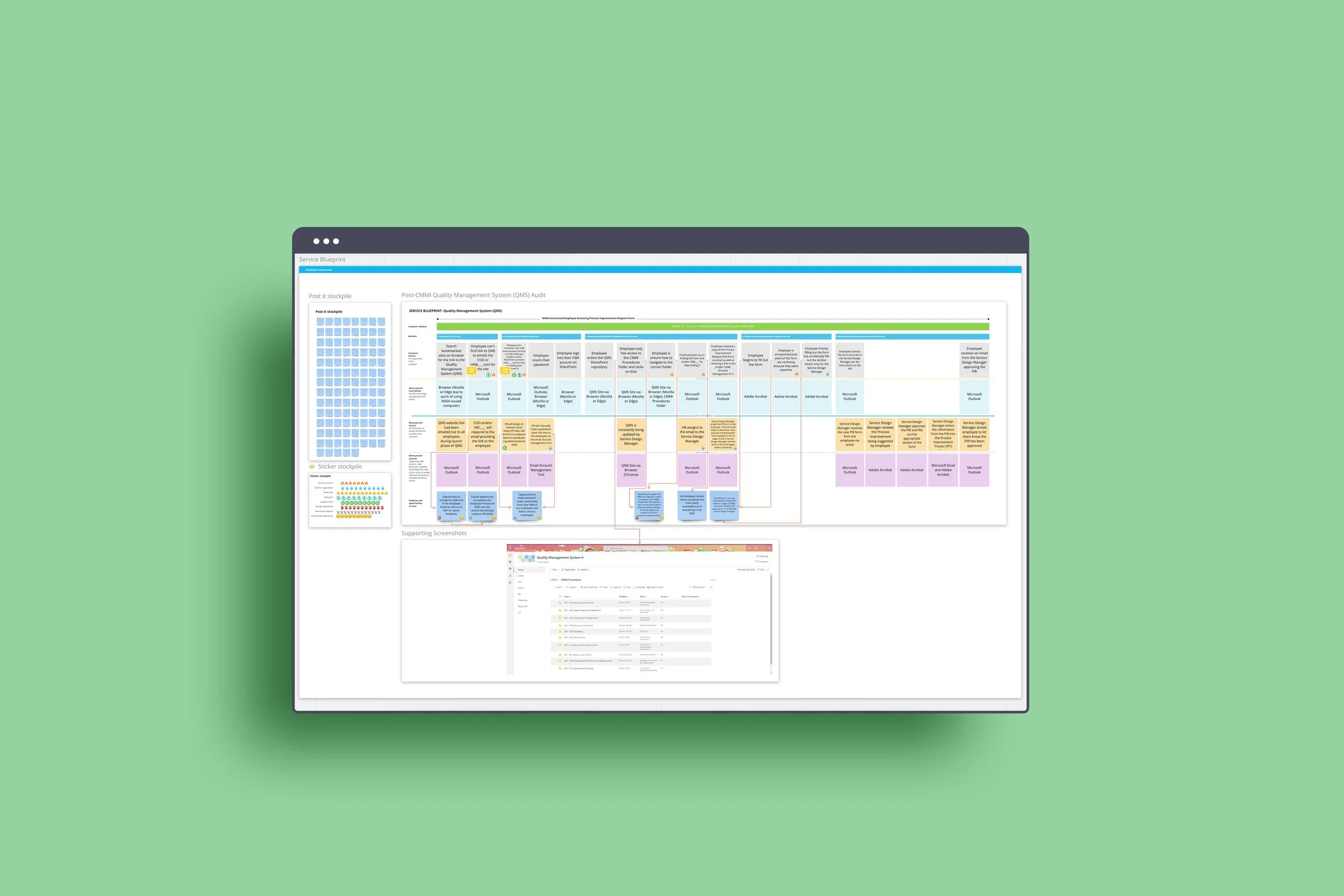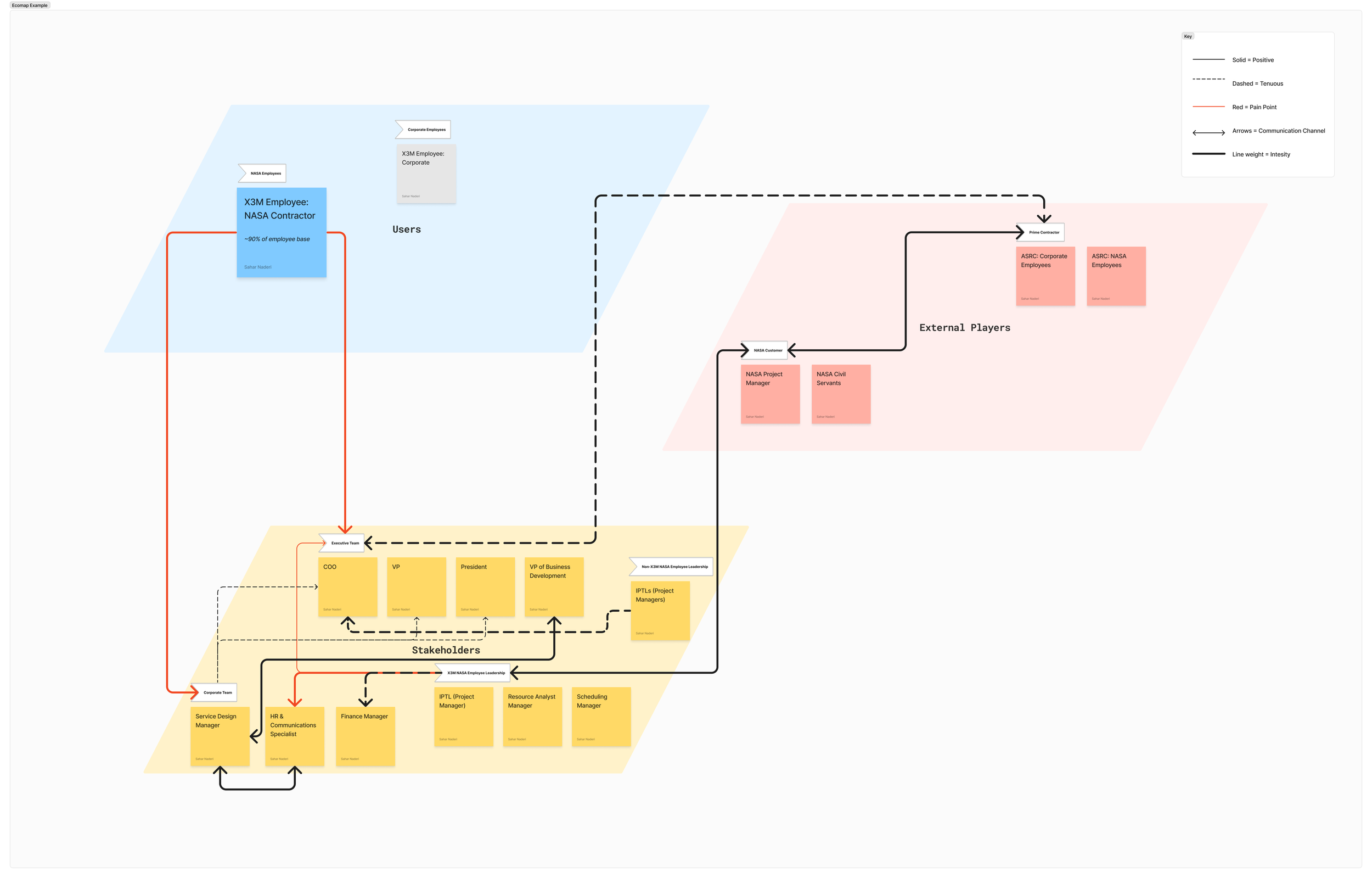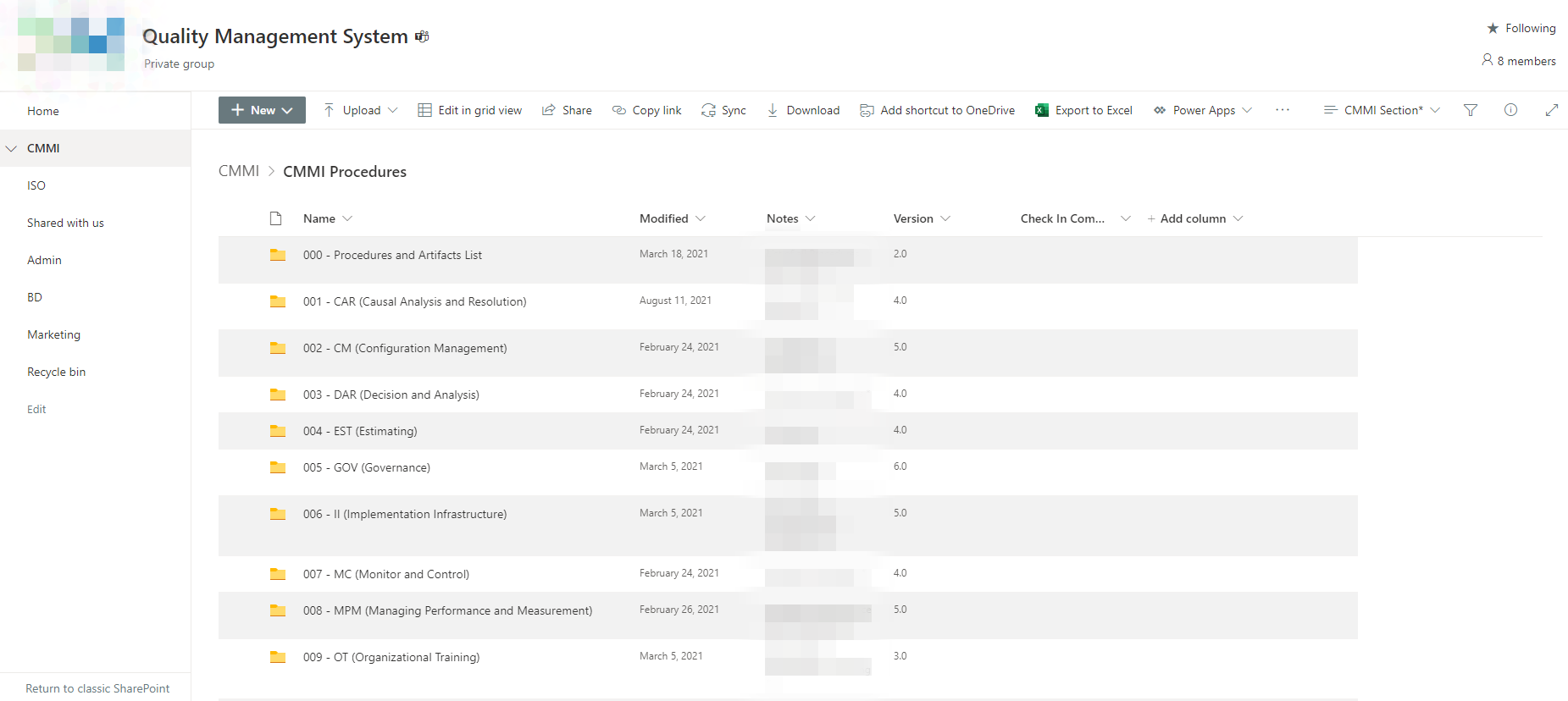Capability Maturity Model Integration (CMMI) Certification
Developing and Implementing CMMI-Conforming Processes for an 8(a) NASA Contractor
🔎 Research Categories: Generative, Evaluative
📝 Project Type: CMMI Certification (Frontstage & Backstage)
🕵️♀️ Role/Contribution: Project Manager, Service Designer, UX Researcher
🗓️ Timeline: 15 months
🛠️ Relevant Tools: Miro, Microsoft SharePoint, Word, Excel, Outlook
🤝 Cross-Functional Team Size: 10
👥 Stakeholders Involved: 20
🔒 Users: 115 internal users (all employees and teams)
*Note: The visuals on this page were created for this case study.
🥅 High-Level Research Objectives:
Attain CMMI Level 3.0 Certification for the company
Design a meaningful and usable Quality Management System (QMS) on SharePoint
Develop and implement streamlined corporate procedures and processes
Background
What is CMMI?
Capability Maturity Model Integration (CMMI), originally developed over a 10-year period at Carnegie Mellon University (CMU) to evaluate the quality and capability of software contractors for the DOD, is now used by diverse organizations, including government agencies like NASA, to assess a company's level of maturity. It is sometimes a requirement for contract proposals.
Problem Statement
As we work towards attaining CMMI 3.0 compliance, we need to create a corporate process structure that is user-friendly and accommodates the requirements of all stakeholders in order to position the company for future growth opportunities while also improving employee experiences.
Service Design & Research Goals
Develop processes and procedures around 24 different practice areas with required documentation (called artifacts) including procedure documents, corporate plans, related forms, tracking matrices, etc.
Design a functional Quality Management System (QMS) site on SharePoint to organize all corporate processes and related documentation
Accomplish CMMI Level 3.0 Certification by end of 2021
Top-Level Diagram of CMMI Practice Areas
Key Insights
Given that approximately 90% of our user base comprises NASA contract employees, it was imperative to align our new corporate processes with their existing mental models.
This approach ensured compliance with CMMI requirements while closely resembling the familiar NASA processes to facilitate a seamless transition for the majority of our users. This also lessened the cognitive load for our users so that they didn’t have to employ two disparate processes simultaneously throughout their workday.Employees feel there is a lack of accessible communication channels with the corporate office.
Through my research, a notable pain point emerged as many NASA employees felt disconnected from the corporate office, resulting in uncertainty about whom to contact for inquiries related to benefits, pay, tax forms, etc. Addressing this, I developed and documented distinct avenues for communication in our Governance Plan, Process Quality Assurance procedure, and Process Asset Development procedure. Introducing an annual anonymous employee survey also proved invaluable in gathering feedback that might have otherwise been missed. Furthermore, we enhanced corporate communication pathways, ensuring clarity and responsiveness, thereby enabling employees to receive prompt answers to their questions.Identifying a strategic opportunity from past engagements, we recognized the potential to enhance our employee benefits package with additional training offerings.
Given our status as a subcontractor, aligning our benefits closely with, or even surpassing, the prime contractor's offerings is essential. This is because, when an employee applies to work for a NASA contract, they don’t have the freedom to decide whether they will be working for the prime or subcontractor. Leveraging an updated Decision Analysis & Resolution process and form, we assessed past group training initiatives undertaken by our employees. This uncovered a cost-saving avenue: implementing a year-long trial of LinkedIn Learning as part of our core benefits to test out the usage and impact on our employee base. This would be followed up with quarterly surveys to determine usefulness and usability of this benefit.
Ecosystem Map showing relationships between all players (Users, Stakeholders, & External Players) as well as highlighting pain points in communication channels
Service Design Impact
User Impact
Our users, the employee base, have more ways to interact with and impact the company such as Process Improvement Requests (PIRs), Causal Analysis & Resolution (CAR) Reports, and more. Through our CMMI implementation efforts, we also enacted a new, anonymous Employee Satisfaction Survey to be administered annually. We received many helpful process improvement suggestions that we may have never received had we expected our users to find and fill out a Process Improvement Request (PIR) form.
Strategic Impact
In 2020, the business grew and onboarded about 2/3 of its current employee base after becoming the subcontractor on a contract. Due to this rapid growth, X3M needed to revisit the inner workings of the business to be able to sustain future growth and large-scale onboarding. This led to the decision to pursue CMMI 3.0 certification.
Because we passed and received CMMI certification, we are on track to spend much of 2022 on Business Development and pursuing new contracts. One contract X3M is bidding on in early 2022 requires CMMI and would lead to onboarding ~2,000 new employees upon the contract start date. CMMI has allowed X3M to be able to handle that influx of new employees.
Business Impact
The company will be eligible to bid more contracts since many government contracts require CMMI and/or ISO certification. CMMI is also a significant differentiator in the competitive government contracting landscape. This promotes company growth through opening up bidding eligibility.
As a small 8(a) company with a lean corporate office, using CMMI to develop and implement our organization’s processes and procedures has provided needed structure to the business.
Additional Comments in Employee Satisfaction Survey
Screenshot from SAM.gov, the official US government system for contract opportunities, here showing contracts that require CMMI compliance
Methodologies
Some of the key methodologies and service design principles are listed below, with explanations as to why they were chosen for this project:
Desk Research: Spent time in the beginning understanding CMMI, its purpose, and how it fit in with our organization. This heavily influenced the implementation of the CMMI model to fit our organization as well as the design of our Quality Management System (QMS).
Human-Centered + Collaborative + Holistic: It was important to consider everyone affected by the service, including backstage and frontstage players. I also made sure to engage stakeholders throughout the process in order to best address their needs throughout the design of the service.
Stakeholder Interviews: Interviewed stakeholders such as the company’s COO, President, and VP to better understand business goals tied to CMMI.
Focus Groups: Met with fronststage users (employees) in groups to understand their needs as well as additional constraints and considerations (such as comparable NASA processes already in place). Users invited to the focus groups included project managers, resource analysts, HR, etc.
Iterative: Took an exploratory and continuous approach to the design of the service.
Prototype: Despite the need for a quick SharePoint build at the start of the project, I devoted significant time to the Information Architecture (IA) of the Quality Management System (QMS) prototype. I created user flows, paper prototypes, and approached the QMS as a living prototype that could be continuously iterated upon.
Service Blueprint: Visualized the relationships between different service components to uncover pain points.
Service Blueprint of a User Flow
Phase 1 of Quality Management System (QMS) on SharePoint
Procedures and Artifacts Tracker
Created to track all artifacts to each corresponding procedure/practice area
Reflections & Learnings
Prototyping and iteration can and will happen continuously with product usage sometimes. Embrace it and dive in.
Information Architecture (IA) is incredibly important, even for internal document organization.
Translating a “model” (CMMI) into a usable system (QMS) is not a 1:1 process. It’s okay and expected that we would have “our own way” of documentation.
Service Design is an interesting blend of UX Research, Information Architecture (IA), Configuration Management (CM), Database Management, and more. Approaching from each of these points of view will provide interesting and meaningful solutions.










